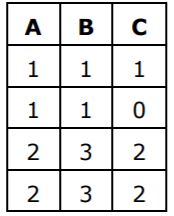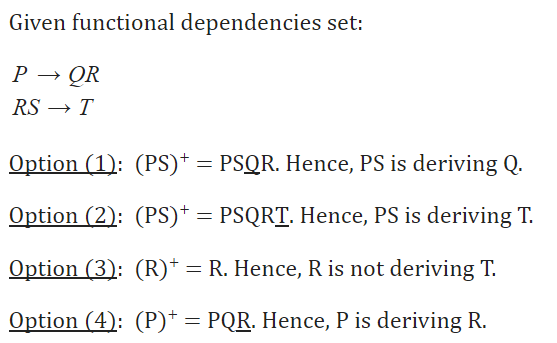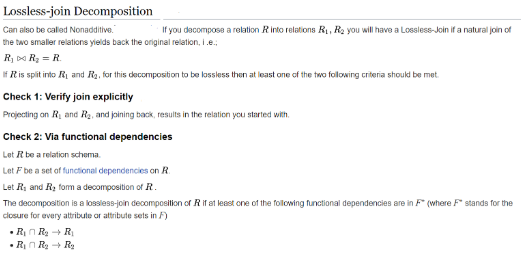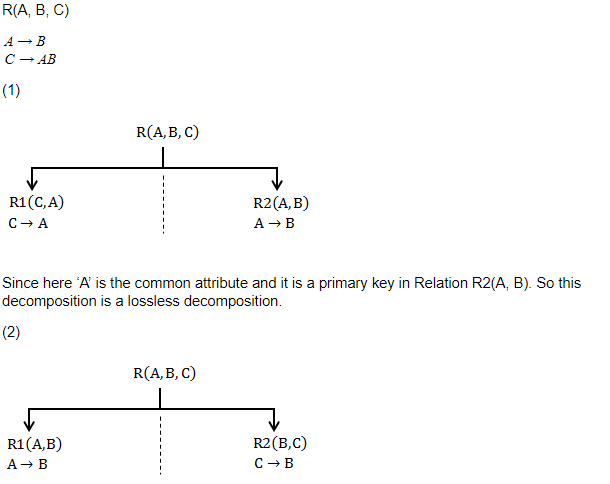Functional-Dependency
Question 1 |
Let R = (A, B, C, D, E, F) be a relation scheme with the following dependencies: C→F, E→A, EC→D, A→B. Which of the following is a key of R?
CD | |
EC | |
AE | |
AC |
A) (CD)+ = cdf
Not a key.
B) (EC)+ = ecdabf
Yes, it is a key.
C) (AE)+ = aeb
Not a key. D) (AC)+ = abcf
Not a key.
Question 2 |
Given the following relation instance.
x y z
1 4 2
1 5 3
1 6 3
3 2 2
Which of the following functional dependencies are satisfied by the instance?
XY → Z and Z → Y | |
YZ → X and Y → Z | |
YZ → X and X → Z | |
XZ → Y and Y → X |
If for t1[A] = t2[A] then t1[Y] = t2[Y].
Question 3 |
Consider a schema R(A,B,C,D) and functional dependencies A → B and C → D. Then the decomposition of R into R1(AB) and R2(CD) is
dependency preserving and lossless join | |
lossless join but not dependency preserving | |
dependency preserving but not lossless join | |
not dependency preserving and not lossless join |
R1∩R2 ≠ 0
Given R1(A,B), R2
R1∩R2 = 0
Not lossless.
The given relation decomposed into R1(A,B) and R2(C,D) and there are only two functional dependencies A→B and C→D. So the given decomposition is dependency preserving.
Question 4 |
From the following instance of a relation scheme R(A,B,C), we can conclude that:

A functionally determines B and B functionally determines C | |
A functionally determines B and B does not functionally determines C | |
B does not functionally determines C | |
A does not functionally determines B and B does not functionally determines C |
But for the given instance it can be seen that B does not functionally determines C, and it can be concluded for entire relation.
Question 5 |
P⟶ QR
RS⟶ T
Which of the following functional dependencies can be inferred from the above functional dependencies?
PS ⟶ Q | |
PS ⟶ T | |
R ⟶ T | |
P ⟶ R |

Question 6 |
AB → C; BC → D; C → E;
The number of superkeys in the relation R is _____________.
8 |
AB → C
BC → D
C → E
¯ The attributes A, B are not there in the right hand side of any of the given FDs.
¯ So, AB can be a candidate key.
(AB)^+ = ABCDE
¯ (AB)^+ is deriving all the attributes of R Hence, AB is a candidate key.
¯ The number of super keys possible for R with “AB” candidate kay is:
2^5 – 2 = 2^3
= 8
Question 7 |
Consider a relation R with five attributes V, W, X, Y, and Z. The following functional dependencies hold: VY → W, WX → Z, and ZY → V.
Which of the following is a candidate key for R?
VXZ | |
VXY | |
VWXY | |
VWXYZ |
Candidate keys are
VXY, WXY, ZXY
Question 8 |
Let R (A, B, C, D) be a relational schema with the following functional dependencies: A → B, B → C, C → D and D → B.
The decomposition of R into (A, B), (B, C), (B, D)
gives a lossless join, and is dependency preserving | |
gives a lossless join, but is not dependency preserving | |
does not give a lossless join, but is dependency preserving | |
does not give a lossless join and is not dependency preserving
|
(A, B, C) (B, D) - common attributes is B and B→D is a FD (via B→C, C→D), and hence, B is a key for (B, D). So, decomposition of (A, B, C, D) into (A, B, C) (B, D) is lossless.
Thus the given decomposition is lossless.
The given decomposition is also dependency preserving as the dependencies A→B is present in (A, B), B→C is present in (B, C), D→B is present in (B, D) and C→D is indirectly present via C→B in (B, C) and B→D in (B, D).
Question 9 |
Consider the relation X(P, Q, R, S, T, U) with the following set of functional dependencies
F = {
{P, R} → {S,T},
{P, S, U} → {Q, R}
}
Which of the following is the trivial functional dependency in F+ is closure of F?
{P,R}→{S,T} | |
{P,R}→{R,T} | |
{P,S}→{S} | |
{P,S,U}→{Q} |
Question 10 |
(X,Y)→ (Z,W) implies X→ (Z,W)
| |
(X,Y)→ (Z,W) implies (X,Y)→ Z | |
((X,Y)→ Z and W→ Y) implies (X,W)→ Z
| |
(X→Yand Y→ Z) implies X→ Z |
Question 11 |
V → W
VW → X
Y → VX
Y → Z
Which of the following is irreducible equivalent for this set of functional dependencies?
V→W V→X Y→V Y→Z | |
V→W W→X Y→V Y→Z | |
V→W V→X Y→V Y→X Y→Z | |
V→W W→X Y→V Y→X Y→Z |
V → W, VW → X, Y → V, Y → X, Y→ Z
Step 2:
V → W, VW → X, Y → V, Y → X, Y→ Z
(V)+ = V ×
(VW)+ = VW ×
(Y)+ = YXZ
(Y)+ = YVW ×
(Y)+ = YVWX
Without Y → X, the closure of Y is deriving ‘X’ from the remaining attributes.
So, we can remove Y → X as its redundant.
Step 3:
V → W, VW → X, Y → V, Y → Z
(V)+ = VW, the closure of V is deriving W from the remaining FD’s.
So, W is redundant. We can remove it.
So, the final canonical form is
V→W, V→X, Y→V, Y→Z
⇾ So, option (A) is correct.
Question 12 |
Consider the relation scheme R = (E, F, G, H, I, J, K, L, M, N) and the set of functional dependencies {{E,F} → {G}, {F} → {I,J}, {E,H} → {K,L}, {K} → {M}, {L} → {N}} on R. What is the key for R?
{E,F} | |
{E,F,H} | |
{E,F,H,K,L} | |
{E} |
B) (EFH)+ = EFHGIJKLMN, EFH is deriving all the attributes of R. So, EFH is a key.
C) If EFH is a key, then EFHKL will become the super key.
D) (E)+ = E
Question 13 |
The following functional dependencies are given:
AB → CD, AF → D, DE → F, C → G, F → E, G → A.
Which one of the following options is false?
{CF}+ = {ACDEFG} | |
{BG}+ = {ABCDG}
| |
{AF}+ = {ACDEFG} | |
{AB}+ = {ABCDFG} |
AF → D
DE → F
C → G
F → E
G → A
CF+ = {G,E,A,D,C,F} = {A,C,D,E,F,G} (✔️)
BG+ = {B,G,A,C,D} = {A,B,C,D,G} (✔️)
AF+ = {D,E,A,F} = {A,D,E,F} (❌)
AB+ = {A,B,C,D,G} (❌)
Question 14 |
Consider a relation scheme R = (A, B, C, D, E, H) on which the following functional dependencies hold: {A → B, BC → D, E → C, D → A}. What are the candidate keys of R?
AE, BE | |
AE, BE, DE | |
AEH, BEH, BCH | |
AEH, BEH, DEH |
So only option (D) contains E and H as part of candidate key.
Question 15 |
((R1∩ R2) →(R1-R2)) ∈ F+ | |
((R1 ∩R2) → (R1 - R2)) ∉ F+ | |
((R1 ∪ R2) →(R1 - R2)) ∈ F+ | |
((R1∩R2) →R1 ) ∈ F+ |

Question 16 |
971658 | |
971659 | |
860547 | |
860548 |
→Subtract each and every digit of given number by digit “9”.
999999
139452
________
860547
Question 17 |
| X | Y | Z |
| X1 | Y1 | Z1 |
| X1 | Y1 | Z2 |
| X2 | Y1 | Z1 |
| X2 | Y1 | Z3 |
R: Z → Y, X → Y, and X → Z | |
R: Z →Y, X → Y, and XZ → Y | |
R: X →Y, X → Z, and XZ → Y | |
R: Z →Y, X → Z, and XZ → Y |
Option 3 is wrong because of X → Z.
Option 4 is wrong because of X → Z
Question 18 |
I. The decomposition of R into R1(C, A) and R2(A, B) is lossless.
II. The decomposition of R into R1(A, B) and R2(B, C) is lossy.
Only I | |
Only II | |
Both I and II | |
Neither I nor II |

Here ‘B’ is common attribute but ‘B’ is not the primary key in any of the decomposed relations (R1 or R2). Hence this decomposition is not a lossless decomposition i.e., it is a lossy decomposition.
Hence, option (C) is correct.
Question 19 |
dependency preserving and lossless join
| |
lossless join but not dependency preserving | |
dependency preserving but not lossless join | |
neither dependency·preserving nor lossless join |
R2(C,D) contains FD C→D
So, yes dependency preserving.
But there is no common attribute between R1 and R2, hence not lossless join.
